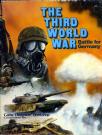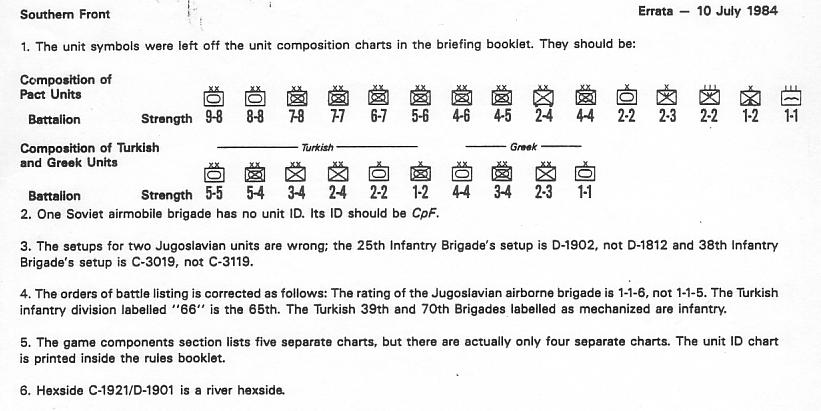The Third World War Series (GDW) Consolidated Errata
 The Third World War is a series of four
games released by Game Designer's Workshop (GDW) from 1984 to
1986. The games simulate a hypothetical conflict between NATO
and the Soviet-led Warsaw Pact at the end of the 1980s. Despite
their age and coverage of a conflict that never eventuated,
these games remain popular enough to prompt a deluxe edition
reprint by Compass Games, containing all four games in one box.
If you own the original games, you may want to buy the new game
for the upgraded components. If you're happy to continue
playing with the original components, you may still want to
benefit from the rule and component corrections. To that end, I
have collected the errata for the original four games into a
single document.
The Third World War is a series of four
games released by Game Designer's Workshop (GDW) from 1984 to
1986. The games simulate a hypothetical conflict between NATO
and the Soviet-led Warsaw Pact at the end of the 1980s. Despite
their age and coverage of a conflict that never eventuated,
these games remain popular enough to prompt a deluxe edition
reprint by Compass Games, containing all four games in one box.
If you own the original games, you may want to buy the new game
for the upgraded components. If you're happy to continue
playing with the original components, you may still want to
benefit from the rule and component corrections. To that end, I
have collected the errata for the original four games into a
single document.
| Revision History | ||
|---|---|---|
| Revision 1.1.1 | 2021-11-29 | |
|
Added air transport/assault air combat procedure from Persian Gulf to The Third World War. | ||
| Revision 1.1.0 | 2021-11-25 | |
|
Added air and naval transport clarifications present in Persian Gulf, but missing from The Third World War. | ||
| Revision 1.0.3 | 2021-11-13 | |
|
Added missing fragment to Section 3B mountain hex ZOC errata. | ||
| Revision 1.0.2 | 2020-12-01 | |
|
Corrected Soviet Card 8 errata typo. | ||
| Revision 1.0.1 | 2020-11-29 | |
|
Retitled Table 1 to Southern Front Victory Table. | ||
| Revision 1.0.0 | 2020-11-28 | |
|
First publication. | ||
The Third World War: Battle for Germany
10 July 1984 Errata
- Expanded Sequence of Play
- The NATO Regroup Phase was omitted from the Expanded Sequence of Play for the NATO First Impulse. It is the last phase in the impulse and should read, “NATO Regroup Phase: All NATO units which did not move or attack in the first impulse and are not in an enemy ZOC may regroup (7).”
- The Second Echelon/Breakthrough Sub-Impulse of the Pact First Impulse should have a Movement Phase and a Combat Phase preceding the Regroup Phase. The note in the sub-impulse refers to these two phases.
- Rules
- 3B Limits of ZOCs: ZOCs (other than airmobile ZOCs and the ZOCs of mountain units) of units in mountain pass hexes extend across mountain pass hex sides only.
- 10A Air Transport: The destination city or airfield must be friendly-controlled at the start of the impulse for units to be air-transported there.
- 10D [Air Transport] Air Combat and Air Defense: Air transport missions (both regular air transport and airborne assault) are similar to other air missions for purposes of air combat and air defense. Air combat occurs as described in rule 9, treating the ground unit being transported as an air unit. If the unit receives an abort (A) or halved (H) result, it returns to the hex it came from. If the unit receives a shot down (SH or SX) result, the effects of the result depend on the type of air transport mission. For regular transport, the unit returns to the hex it came from and receives two disruptions. For airborne assaults, the unit is eliminated. In either case, a shot down result permantently destroys half (round fractions up) of the air transport points being used for the mission. Only airborne assault missions are subject to air defense fire.
- 11A Naval Transport: The [destination] port must be friendly-controlled at the start of the impulse.
- 11A Naval Transport: In addition to ports marked on the map, all one-hex islands (that is, an island contained within a single hex) are ports.
- 11B Amphibious Evacuations: An amphibious unit may be evacuated from a partial sea hex that does not contain a port. The hex must be in a naval zone where naval transport/amphibious assault is allowed for the owning player. The amphibious unit may be withdrawn from the hex and transported by sea to a friendly-controlled port. A unit that is evacuated immediately suffers two disruptions.
- 19 Surrender: If a country surrenders, all ground and air units of that country are immediately removed from play.
- Counters
- The British 9th Attack Helicopter Regiment setup hex is B-0113, not A-0113.
- Warsaw Pact Order of Battle
- 10 Army: “19(C) MRD (7-7-5)/3” should be “(5-6-3).”
- 4 Guards Tank Army: “36 TD” should be “38 TD” and “4GTA AmobB (2-3-7)/PO” should be “4GTA AmobB (2-3-7/1.”
- Western Theater Air Units: There are 2, not 3, Czech MiG-21s.
- NATO Order of Battle
- The French 5th Armored Division setup hex is GE:A1709, not 1706.
- The Canadian 4th Mechanized Brigade setup hex is GE:A1408, not 1418.
- The Danish LG Mechanized Brigade is 1-2-6, not 2-3-5.
- Western Theater Air Units: The Belgian and Netherlands F-16 ratings are swapped. The Danish F-16 was omitted: 1 Dn F-16 (4*-1-2*-M/5).
- Turn 2 Air Units: The F-15E is US.
Southern Front: Race for the Turkish Straits
30 January 1985 Errata
- Rules
- 10 Air Transport: NATO may use 4 air transport points per NATO first and second impulse (but none in the reserve impulses); the Pact may use 12 air transport points per Pact first and second impulse. Air transport points are used during the movement phases. In a Pact impulse, the 12 points may be split between the movement phases of the sub-impulses as the Pact player wishes, as long as no more than 12 are used per impulse.
20B Victory: An incorrect version of the victory table was printed. The correct version is:
Table 1. Southern Front Victory TableVictory Points Result 21 or less NATO overwhelming victory 22-26 NATO substantial victory 27-30 NATO marginal victory 31-34 PACT marginal victory 35-48 PACT substantial victory 49 or more PACT overwhelming victory
- The following rules from Southern Front are also used when playing the combined game: 6B The Bosporus and 19 Balkan Nations which Surrender.
- Charts
- The unit symbols were left off the unit composition charts in the briefing booklet. See Figure 1 for the chart.
- The game components section lists five separate charts, but there are actually only four separate charts. The Unit ID Chart is printed inside the rules booklet (on page 15).
- Division Size Chart: A Greek armored division is two brigades in size, not one.
- Map
- Hex side C-1921/D-1901 is a river hex side.
- The mountain passes extending south from hexes E-0110 and E-0111 connect to the mountain pass in hex D-3210.
- Counters
- One Soviet airmobile brigade has no unit ID. It should be CpF.
- The setup for two Jugoslavian units are wrong; the 25th Infantry Brigade's setup is D-1902, not D-1812 and 38th Infantry Brigade's setup hex is C-3019, not C-3119.
- Order of Battle
- The rating of the Jugoslavian airborne brigade is 1-1-6, not 1-1-5.
- The Turkish infantry division labeled 66 is the 65th.
- The Turkish 39th and 70th Brigades labeled as mechanized are infantry.
Arctic Front: Battle for Norway
10 November 1985 Errata
- Rules
- 20A Victory: The Pact player receives one victory point for each airfield he controls.
- Charts
- On the Unit Types Chart, the air transport cost for Mechanized Infantry/Motorized Rifle should be 5, not 4.
- On the Combat Results Table, the combat result for a roll of 2 at 8:1 odds should be D/4DR, not -/4DR.
- Counters
- The neutral reaction chit for Swedish limited participation should read “Turn 3,” not “Turn 2.”
- The Swedish 2nd Armored Brigade's setup hex is G-0211, not F-0211.
- The Tu-22M's strike rating should have all-weather capability.
Persian Gulf: Battle for the Middle East
14 July 1986 Errata
- Rules
- Players gain control of off-shore oil fields by moving their airmobile units through those hexes.
- Charts
- National/Factional Data Chart: Afghanistan does have chemical ability; its entry for this on the chart should be “YES,” not “NO.”
- Persian Gulf Reference Map: This map is mislabeled as the Conference Map.
- Cards
- U.S. Card 10 (Invade/Intervene): The effect on the Centrists should be “1 Sov,” not “1 U.S.”
- Soviet Card 8 (Syrian Intervention): The asterisk line should read “*1 Sov if IRG to U.S.”
- Soviet Card 10 (Invade/Intervene): The effect on Syria should be “1 U.S.*,” not “1 Sov*.”
- Counters
- The U.S. B-52 air unit should have a range of “I,” not “L,” and should have an all-weather strike rating.
- The U.S. F-15 air unit should have a reinforcement code of “ALERT 1,” not “ALERT.”
Credits
Portions of this document are drawn from the original errata as issued by GDW and rewordings of that errata submitted to grognard.com by Elias Nordling and Ross Hagglund.

